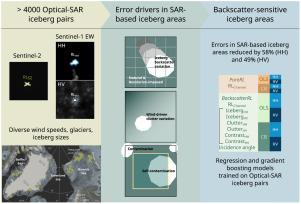基于Sentinel-1 Extra Wide Swath SAR数据的后向散射敏感冰山区域检索
IF 11.4
1区 地球科学
Q1 ENVIRONMENTAL SCIENCES
引用次数: 0
摘要
本文首次系统地研究了利用Sentinel-1超宽条SAR数据检索北极冰山区域的方法。我们的数据集包含4014座开放水域的北极冰山。为了检测Sentinel-1图像中的冰山,我们采用了恒定虚警率(CFAR)算法。2016年5月至2023年9月期间,冰山在同一位置的Sentinel-1和光学Sentinel-2采集中进行匹配。Sentinel-1冰山面积与Sentinel-2参考面积有一定的相关性,在HH-和hv偏振处Pearson的r值分别为0.65和0.69。CFAR算法大多高估了两个通道的冰山面积,但在冰山后向散射较低的情况下,有时会低估HV通道的冰山面积。第10百分位和第90百分位的相对误差分别为-36%和+569%,hv偏振为-37%和+349%。除了分辨率施加的误差大小依赖性外,我们发现HH海洋杂波与相对误差呈中度负相关(Pearson 's r值:-0.64)。此外,我们观察到HH (HV)冰山后向散射与Sentinel-2冰山面积之间存在弱相关性,Pearson的r值为0.34(0.26)。我们利用分析的关系来预测Sentinel-1数据的冰山面积,使用梯度增强回归。对后向散射敏感的检索模型比对后向散射不敏感的模型产生更精确的冰山面积。在HH (HV)信道中,前两种模型的平均绝对误差降低了58%(49%)。对冰山区域的后向散射敏感检索将促进在夏季对北极冰山区域进行一致的基于sar的观测。未来的研究需要量化冰山面积检索和冰山探测性能对冰山面积分布和冰山总面积的综合影响。本文章由计算机程序翻译,如有差异,请以英文原文为准。

Backscatter-sensitive retrieval of iceberg areas from Sentinel-1 Extra Wide Swath SAR data
We present the first systematic study on Arctic iceberg area retrieval from Sentinel-1 Extra Wide Swath SAR data. Our dataset contains 4014 Arctic icebergs in open water. To detect icebergs in Sentinel-1 images, we applied a constant false alarm rate (CFAR) algorithm. Icebergs were matched in co-located Sentinel-1 and optical Sentinel-2 acquisitions for a period from May to September in the years 2016 to 2023. The Sentinel-1 iceberg areas are moderately correlated with the Sentinel-2 reference areas, with Pearson’s r-values of 0.65 at HH- and 0.69 at HV-polarization. The CFAR algorithm mostly overestimates iceberg areas in both channels, but in some cases underestimates iceberg areas in the HV channel when the iceberg backscatter is low. The 10th and 90th percentiles of the relative error are -36% and +569% at HH-, and -37% and +349% at HV-polarization. In addition to a resolution-imposed size-dependency of the error, we find that the HH ocean clutter is moderately negatively correlated with the relative error (Pearson’s r-value: -0.64). Additionally, we observe weak correlations between the HH (HV) iceberg backscatter and the Sentinel-2 iceberg area, with a Pearson’s r-value of 0.34 (0.26). We utilize the analyzed relationships to predict iceberg areas from Sentinel-1 data, using a gradient boosting regression. Backscatter-sensitive retrieval models yield more accurate iceberg areas than backscatter-insensitive models. In the HH (HV) channel, the former models reduce the mean absolute error by 58% (49%). Backscatter-sensitive retrieval of iceberg areas will foster consistent SAR-based observations of Arctic iceberg areas during summer months. Future studies need to quantify the combined impact of iceberg area retrieval and iceberg detection performance on area distributions and total iceberg areas.
求助全文
通过发布文献求助,成功后即可免费获取论文全文。
去求助
来源期刊

Remote Sensing of Environment
环境科学-成像科学与照相技术
CiteScore
25.10
自引率
8.90%
发文量
455
审稿时长
53 days
期刊介绍:
Remote Sensing of Environment (RSE) serves the Earth observation community by disseminating results on the theory, science, applications, and technology that contribute to advancing the field of remote sensing. With a thoroughly interdisciplinary approach, RSE encompasses terrestrial, oceanic, and atmospheric sensing.
The journal emphasizes biophysical and quantitative approaches to remote sensing at local to global scales, covering a diverse range of applications and techniques.
RSE serves as a vital platform for the exchange of knowledge and advancements in the dynamic field of remote sensing.
 求助内容:
求助内容: 应助结果提醒方式:
应助结果提醒方式:


